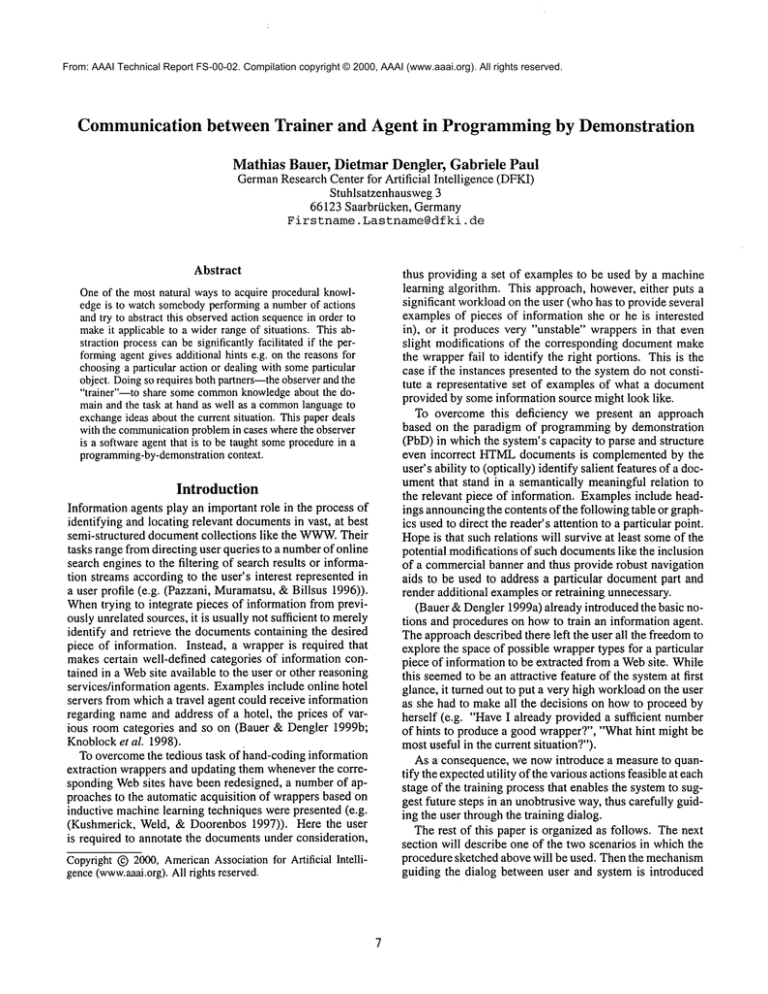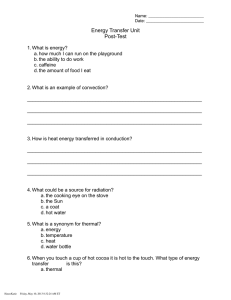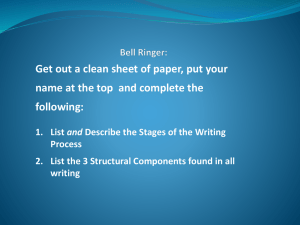
From: AAAI Technical Report FS-00-02. Compilation copyright © 2000, AAAI (www.aaai.org). All rights reserved.
Communication between Trainer and Agent in Programmingby Demonstration
Mathias Bauer, Dietmar Dengler, Gabriele Paul
GermanResearch Center for Artificial Intelligence (DFKI)
Stuhlsatzenhausweg 3
66123 Saarbrticken, Germany
Firstname. Lastname@dfki.de
Abstract
Oneof the mostnatural waysto acquire proceduralknowledge is to watchsomebody
performinga numberof actions
andtry to abstract this observedaction sequencein order to
makeit applicableto a widerrangeof situations. Thisabstraction processcanbe significantlyfacilitated if the performingagent gives additionalhints e.g. on the reasonsfor
choosinga particular action or dealing withsomeparticular
object. Doingso requires bothpartners--theobserverand the
"trainer"--to share somecommon
knowledgeabout the domainand the task at handas well as a common
languageto
exchangeideas aboutthe current situation. Thispaperdeals
with the communication
problemin cases wherethe observer
is a softwareagent that is to be taughtsomeprocedurein a
programming-by-demonstration
context.
Introduction
Informationagents play an important role in the process of
identifying and locating relevant documentsin vast, at best
semi-structured documentcollections like the WWW.
Their
tasks range fromdirecting user queries to a numberof online
search engines to the filtering of search results or information streams according to the user’s interest represented in
a user profile (e.g. (Pazzani, Muramatsu,& Billsus 1996)).
Whentrying to integrate pieces of information from previously unrelated sources, it is usually not sufficient to merely
identify and retrieve the documentscontaining the desired
piece of information. Instead, a wrapper is required that
makescertain well-defined categories of information contained in a Website available to the user or other reasoning
services/information agents. Examplesinclude online hotel
servers from whicha travel agent could receive information
regarding nameand address of a hotel, the prices of various room categories and so on (Bauer & Dengler 1999b;
Knoblocket al. 1998).
To overcomethe tedious task of hand-coding information
extraction wrappers and updating them wheneverthe corresponding Websites have been redesigned, a numberof approaches to the automatic acquisition of wrappers based on
inductive machinelearning techniques were presented (e.g.
(Kushmerick, Weld, & Doorenbos 1997)). Here the user
is required to annotate the documentsunder consideration,
Copyright@2000, AmericanAssociationfor Artificial Intelligence(www.aaai.org).
All rights reserved.
thus providing a set of examples to be used by a machine
learning algorithm. This approach, however, either puts a
significant workloadon the user (whohas to provide several
examplesof pieces of information she or he is interested
in), or it produces very "unstable" wrappers in that even
slight modifications of the corresponding documentmake
the wrapperfail to identify the right portions. This is the
case if the instances presented to the systemdo not constitute a representative set of examplesof what a document
provided by someinformation source might look like.
To overcome this deficiency we present an approach
based on the paradigm of programming by demonstration
(PbD)in which the system’s capacity to parse and structure
even incorrect HTML
documents is complemented by the
user’s ability to (optically) identify salient features of a document that stand in a semantically meaningful relation to
the relevant piece of information. Examplesinclude headings announcingthe contents of the followingtable or graphics used to direct the reader’ s attention to a particular point.
Hopeis that such relations will survive at least someof the
potential modifications of such documentslike the inclusion
of a commercialbanner and thus provide robust navigation
aids to be used to address a particular documentpart and
render additional examplesor retraining unnecessary.
(Bauer &Dengler 1999a) already introduced the basic notions and procedures on howto train an information agent.
The approachdescribed there left the user all the freedomto
explore the space of possible wrappertypes for a particular
piece of information to be extracted from a Website. While
this seemedto be an attractive feature of the systemat first
glance, it turned out to put a very high workloadon the user
as she had to makeall the decisions on howto proceed by
herself (e.g. "HaveI already provided a sufficient number
of hints to produce a good wrapper?", "Whathint might be
mostuseful in the current situation?").
As a consequence, we nowintroduce a measure to quantify the expectedutility of the variousactions feasible at each
stage of the training process that enables the systemto suggest future steps in an unobtrusiveway, thus carefully guiding the user throughthe training dialog.
The rest of this paper is organized as follows. The next
section will describe one of the two scenarios in which the
procedure sketched above will be used. Then the mechanism
guiding the dialog between user and system is introduced
before the communicationproblem is analyzed and future
directions are discussed.
Task Description
The InfoBean concept as introduced in (Bauer & Dengler
1999a) is an approachto the system-supportedconfiguration
of individualized information services. The commoninterface of the individual services is provided using a standard
Webbrowser displaying a specific HTML
page. Additionally, there is an InfoBeanmanagement
service on client side
providing Save/Loadfunctionality w.r.t. InfoBeanconfigurations as well as a proxyservice in order to connect to the
script evaluation engine. Onserver side this engine is implementedas a multi-threaded script interpreter on top of a
script database.
Roughlyspeaking, an InfoBeanrepresents a primitive information service. AnInfoBoxconsisting of various interconnected InfoBeans then is a complexservice integrating
information from previously unrelated sources where the
flow of information is determined by the links drawn betweenits primitive constituents.
To be a little moreprecise, the term InfoBeandescribes
a configurable componentthat either encapsulates an existing informationservice or specifies a process of information
gathering and providing. Such a component communicates
with its environmentthrough channels that serve the purpose
to pass information to or obtain data from other components.
The interplay of connected componentsthus defines an
information integration network. The input channels of an
InfoBean can be connected with output channels from various other InfoBeansthat provide input data in an appropriate
format.
Figure 1 shows a screenshot of the browser interface
wherethe user has configuredan InfoBoxto satisfy her interest in cybercast music events (see (Bauer &Dengler 1999a)
to read moreabout the configuration of an InfoBox).
The InfoBoxconsists of five InfoBeansmarkedin the figure by numbers 1 to 5, respectively. Running InfoBean 1
provides the current date in its display area as well as an
output channel. In the same way, InfoBean 2 provides some
personal information of the user. InfoBean 3 is the essential part of the music event service. Using the date delivered by InfoBean 1 it searches on the "Houseof Blues Online" (HOBOnline) server for broadcast online events w.r.t.
the given date. As output it produces a table with columns
"artist", "time of event", and "reminderservice input data".
An"artist" value can fill the input channel of InfoBean4,
which searches on the "Ultimate BandList" server to find
an appropriateentry for the given artist and then selects only
that biography field which the user has decided is of most
interest for her. Finally, InfoBean5 realizes an automatic
reminder service on a chosen event (by clicking on a value
in the third columnof InfoBean 3) using information from
the user’s profile. It automaticallyfills the appropriate form
at "HOB
Online" with the effect of an email reminder to be
sent to the user one hour before the broadcast event starts.
The wrappers realizing the InfoBeans3 to 5 have been built
by the user in a cooperative dialog with the systemsupported
by the technique of "programmingby demonstration". Later
on in this paper, wewill demonstratein detail a samplePbDsession aiming at building the wrapperfor InfoBean3.
The PbD Dialog
The aim of a training session is to construct from one sample selection a HyQLwrapperthat is as robust as possible,
i.e. the wrappershould tolerate minor changes of the HTML
page.1 To this end the user simply marksthe interesting part
of the documentusing the mouse.Apart from identifying the
informationto be extracted by the wrapper,the user can also
give additional hints by pointing at relevant features of the
selection, such as a specific style or format, or by identifying
the selection as a concept defined in a given ontology. Furthermore,the definition of a context, i.e. an area surrounding
the part to be extracted, mightbe useful, if the context itself
can be easily characterized and localized within the document(e.g. a table containing the highlighted portion of the
document)as it reduces the search space for the localization
of the selection. A landmarkcan also be used as a navigation
aid or as an additional characterization of the selection (e.g.
a graphics immediatelypreceding the highlighted text).
Dependingon the user’s choice a unique characterization
of the relevant information and thus, the effective construction of the wrapperitself, can be achievedeither in an automatic modeor with an active system that makessuggestions
for the best actions to be taken next in a dialog window.
In the latter modethe systemmaintainsin each step a list
of ranked suggestions for possible next actions amongwhich
the user is free to choose. Thus, given a selection, a wrapper
assessment is computedtaking into account different contexts or landmarkswhichthe systemconsiders useful (in the
abovesense of leading to a robust identification of the target
concept). A valuation function then helps to determine what
suggestionis best by computinga value representing the expected utility of the suggestion within the training dialog.
This process is described belowin moredetail.
Input Parameters
Apart from the HTML
document, which is preprocessed into
an HTML
parse tree, the PBDsystem works with a wrapper hierarchy. This library consists of a numberof wrapper
classes where each class has associated some HyQLtemplate, i.e., building blocks to form fully functional informationextraction scripts, together with a description of the
parameters yet to be instantiated. In addition, each wrapper class is given a numericalintrinsic valuation whichis
intended to represent the estimated robustness of this type
of wrapper. For examplea wrapper that simply counts all
tags (HTML
formatting instructions) of the documentpreceding the selection is morelikely to fail than a moresophisticated wrapperthat relates the selection to a surrounding table. Thus,the latter has a higher intrinsic valuation.
1HyQL
is an SQL-likeWeb-querylanguagethat allows both
navigation over the Weband within one single document.Being
a very expressivelanguage,HyQL
allows document
portions to be
describedat a rather high,abstractlevel whichfacilitates the task of
producingrobust wrappers.For an introductionto HyQL
the reader
is referred
to www.dfki.de/~dengler/hyql
tutor,
html.
Figure 1: A sample InfoBox.
A function describing the user’s skill (in terms of probabilities of correct answersto certain types of questions) is
given as another input parameter to computethe utility of
a suggestion. The system provides default values modeling
naive or expert users.
General Wrapper Construction
Givena selection, a set of feasible wrapperclasses is determined according to the hierarchy. For each hypothetical
wrapper the corresponding assessment is computedtaking
into account
the intrinsic assessments of the various HyQLtemplates
to be used,
heuristic assessments of the way these componentswill
zbe combined,
¯ the acceptanceby the user.
As the assessmenttakes into accountthe cost for localizing
the selection, it also dependson the existence of a "good"
context and/or landmark.Candidatesfor a context are, e.g.,
HTML
tags surrounding the selection, default context is the
complete document. A good context should in addition be
"easy"to localize.
The system also looks for landmarks such as images,
bold-face headings, text ending with a colon, special separators, table headings etc. Thus, each wrapperis assigned
an assessments taking into account the respective combination of context and landmark, where candidates not exceedeThisserves the purposeto prefer simple wrappersover more
complicatedones, as the formerare expectedto be morerobust.
Forexample,the search for "the first bold-facewordin the first
table" is considered
to be less fragile thanthe searchfor "the 245th
bold-face wordin the document",evenif both producethe same
outcomefor the current document.See (Bauer, Dengler,&Paul
2000)for details.
ing a certain localization threshold are discarded. Choosing a context corresponds to a recursive call of the system
with the context given as selection. To avoid querying the
user about all possible contexts and to provide a recursion
end the context is characterized automatically. The user is
also not askedfor additional hints. This follows the supposition that multiple layers of selection, context and landmark
do not add to the overall robustness, as possibly too much
structural information of the documentis used such that its
modificationis likely to affect this combination.
Given the assessments the system tries to determine the
utility of possible suggestions e.g. regarding a better landmark and/or context to improve the assessment of the favoredwrapper,further specifications of the selection, or the
termination of the dialog. At any time the user is allowed to
take the initiative and give somehints to further specify the
selection or point to relevant features. Sucha hint mayserve
either as a landmark,i.e., it is incorporatedinto the wrapper
to specify the path to the selection in the document
or it may
serve to further characterize the selection.
To summarize, the training dialog starts with the user
markingthe desired portion of the document.Then the system suggests a numberof actions that are expected to increase the estimated wrapper quality. The user accepts one
of these suggestions or decides to do somethingcompletely
different and so forth until a seemingly good wrapper was
produced.
The Communication
Problem
Effective communicationbetween user (trainer) and agent
(student) is hard to achieve. This is particularly true in scenarios like the one sketched abovewhere an agent is to be
trained to interact with an already existing application that
was not designed to be "programmed"this way.
One of the most fundamental obstacles is the lack of
visual/semantic
procedural
domain
structural
Figure 2: Knowledgeshared by user and agent.
shared knowledgeor insight into the various aspects of the
training task at hand. Asdepicted in Figure 2, at least four
different types of informationplay a key role during a training dialog.
¯ Structural knowledgerefers to the internal properties of
the programmingdomain (in this case, the HTML
structure of a documentto be processed).
¯ Procedural knowledgerefers to the understanding of (at
least) the basic concepts of the target programming
language (in this case, HyQL)and the way the programs
to be developedare intended to work (here, the principle
functioning of wrappers).
¯ The visual~semantic category comprises the optical perception of the application systemto be dealt with, the representation of domainobjects and its interpretation allowing e.g. semantic relationships to be derived. Examples
include the rendering of an HTML
documentin a browser
and the identification of someparticularly formattedportion of text as a heading describing the subsequent paragraph.
¯ Finally, domainknowledgeincludes the basic understanding of concepts from the application domain(e.g. about
hotels, roomcategories etc.) and the wordingtypically
used to describe them.
These various categories are not mutually independent.
Rather, a lack of structural knowledgeprevents a sufficiently
deep insight into the procedural aspects of the task at hand;
little or no domainknowledgeexacerbates the interpretation
of visual encodingof information beyondpurely syntactical
aspects etc. Unfortunately, only a relatively small part of
this information is shared by user and agent and can thus be
used for communicationpurposes.
As is depicted in Figure 2 the learning agent, for example, may possess deep insight into the (programming)domainstructure. In the given example,this refers to the system’s ability to evaluate and exploit the underlying document structure induced by the HTML
code.
Whilethe typical user can be expected to have somebasic
understanding of HTML
at best, this overlap usually proved
to be insufficient to explain the systembehavior--its sug-
10
gestions regarding next actions or wrapper components-3referring to such structural documentproperties.
The user’s most prominent capability is in interpreting
and understanding the visual appearanceof a documentin
her Webbrowser. Doingso, she can easily identify "important", never-changing aspects of a documentand semantic
relationships amongobjects (e.g. a graphics and its title)
exploiting her background domain knowledge. The system,
on the other hand, has to rely on a numberof more or less
feasible heuristics (such as "the first line of a table column
typically contains a header describing its contents") in order to at least makea guess of whichobjects are related and
might thus makea good navigation aid.
The coverageof proceduralaspects of the training task---i.e. details of the target languageand the general functioning
of wrappers--largely depends on the user’s experience in
such training activities on the one hand and on the system’s
learning bias on the other hand.
Even without taking into account misconceptions on either side, 4 the abovediscussion indicates that an effective
communicationproviding perfect mutual understanding of
both partners is almost impossible.
Whatare the consequencesfor the training dialog in the
InfoBeans scenario? Obviously there exist two almost disjoint, complementarycompetenceareas. The learning agent
suggests the next actions to be taken or wrappercomponents
(e.g. a landmark)to be used mainlybased on its understanding of the underlying HTML
structure. The user--in her
role as a trainer--evaluates these suggestions based on her
domainknowledgeand the visual impression of the document’s rendering in the browser. Dependingon the user’s
estimated expertise, either the agent autonomouslydecides
on howto continue the training dialog--that is, the user is
only presented the seemingly best action at each point in
time----or the user is free to accept or ignore the agent’s suggestions, taking over control by herself.
Adding image processing capabilities to the learning
agent, as is donein (Amantet al. 2000)enablesit to (at least
partially) understandthe structure and functionality hidden
in the user interface. In terms of the abovecategories this
meansthat the agent’s coverage of the "visual" information
portion is significantly extended. Equippedwith this enhancedinsight into the visual appearanceof an application,
the agent can try to immediatelyinterpret and generalize the
user’s interaction with the various interface elements, thus
enabling it to programapplications without an API.
Applications specifically designed to be programmedby
demonstration try to bridge the gap betweenuser and system by providing a visual access to both the programming
domainstructure and the procedural aspects of the program
to be developed.A typical exampleof this class is Stagecast
3Thefact that the samevisual renderingcan be achievedusing
a numberof different HTML
encodings--just think of the many
creative waysto use tables--aggravates
this problem
as it is almost
impossibleto correctly guessthe actually used HTML
codeby just
lookingat its rendering.
4Someof the heuristics used by the systemmightbe perfectly
wrong,just as a user’ s guessof the document
structurederivedfrom
its visualappearance.
(Smith, Cypher, &Tesler 2000), a system intended to enable
its user to programa kind of video games. The world inhabited by various kinds of creatures has the structure of a (visually perceivable) grid, and programsteps consist of simple
state transition rules representedby the respective states before and after rule application.
Even here, however, not all interaction can be solely
grounded on visual perception. Instead, the user must be
willing to delve into someof the more advancedfeatures of
the systemin order to describe whatis called "hiddenstates"
in (McDaniel2000). This notion refers to additional aspects
of the world that cannot be inferred from just one example,
but haveto be explicitly stated by the user or inferred by the
system. In the Stagecast example, such additional information includes abstractions like "any kind of object should be
in this place in order to makethe rule applicable" or "variables" that represent the internal state of the characters.
This perspective is somewhatsimilar to the one taken in
the Gamutproject (McDaniel2000) where the user is considered to be actually programming.That is, the user is
in charge of conveyingall required information to the system which in turn has to provide appropriate communication
channelsto facilitate this task for the user.
While this maybe acceptable in applications like InfoBeanswherethe user is actively trying to establish a certain informationservice, this definitely differs from scenarios like TrlAs (Bauer &Dengler1999b)5 wherethe user initially did not intend to programa system, but to use it. As a
consequenceshe cannot be expected to be infinitely patient
and willing to invest her time and effort to teach the system
something she expected it to already know.In other words,
it’s not (only) about makinglearning as easy as possible for
the agent (compare(VanLehn1987)), but also to facilitate
the teaching process for the user. Thusthe system’s contribution must clearly exceed the simple check for structural
properties of a document.In TrlAs this additional accomplishment is achieved by the library of numericallyassessed
wrapper componentsand the strong heuristics enabling the
system to hypothesize semantic relationships among(graphical) objects.
user can talk in terms like "the imageto the left of the heading" etc.
Acknowledgment
Wewouldlike to thank Robert St. Amantwhose"visual generalization" approach provided a lot of inspiration for our
ownfuture work.
References
Amant,R. S.; Lieberman,H.; Potter, R.; and Zettlemoyer,
L. 2000. Visual Generalization in Programmingby Example. In Lieberman(2000). to appear.
Bauer, M., and Dengler, D. 1999a. InfoBeans - Configuration of Personalized Information Services. In Maybury,
M., ed., Proceedingsof the 1999 International Conference
on bztelligent Userbzterfaces (IUI ’99), 153-156.
Bauer, M., and Dengler, D. 1999b. TrIAs: Trainable Information Assistants for Cooperative ProblemSolving. In Etzioni, O., and MiJller, J., eds., Proceedingsof
the 1999 International Conference on AutonomousAgents
(Agents’99), 260-267.
Bauer, M.; Dengler, D.; and Paul, G. 2000. Programming
by Demonstration for Information Agents. In Lieberman
(2000). to appear.
Knoblock,C.; Minton,S.; Ambite,J.; Ashish, N.; Modi,P.;
Muslea, I.; Philpot, A.; and Tejada, S. 1998. ModelingWeb
Sources for Information Integration. In Proceedingsof the
15th National Conference of the AmericanAssociation for
Artificial Intelligence.
Kushmerick,N.; Weld, D.; and Doorenbos, R. 1997. Wrapper induction for information extraction. In Proceedings
of the 15th bzternational Joint Conferenceon Artificial Intelligence, 729-735. Nagoya, Japan: Morgan Kaufmann
Publishers.
Lieberman, H., ed. 2000. Your Wish is My Command:
Giving Users the Powerto Instruct their Software. Morgan
KaufmannPublishers.
McDaniel, R. 2000. Demonstrating the Hidden Features
That Makean Application Work. In Lieberman(2000).
appear.
Pazzani, M.; Muramatsu,J.; and Billsus, D. 1996. Syskill
&Webert: Identifying Interesting WebSites. In Proceedings of the 13th National Conferenceof the AmericanAssociation for Artificial Intelligence, 54--61.
Smith, D.; Cypher, A., and Tesler, L. 2000. Novice ProgrammingComesof Age. In Lieberman(2000). to appear.
VanLehn,K. 1987. Learning one Subprocedure per Lesson. Artificial Intelligence 31:1-40.
Future Directions
Fromour perspective the key to improveduser-agent communicationlies in the extension of that knowledgethat is
shared between both partners (compare Figure 2). As
probablywouldnot be acceptable to teach all potential users
the details of the underlying programminglanguages and
domainobject structures, the only way to go is to extend
the agent’s capabilities such as to provide somecommon
understanding--and thus, a commonlanguage----of what is
goingon during the training sessions.
At least the Internet Explorer provides meansto localize
(in a geometric sense) HTML
structures within the rendering of a document.Usingthese values, it is not that difficult
to implementa form of spatial reasoning such that agent and
Sin this scenariothe user helps a web-based
applicationlike a
travel agent overcome
difficulties in dealingwith newor modified
informationsources.
11





